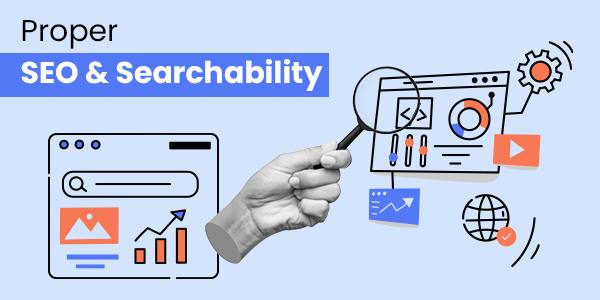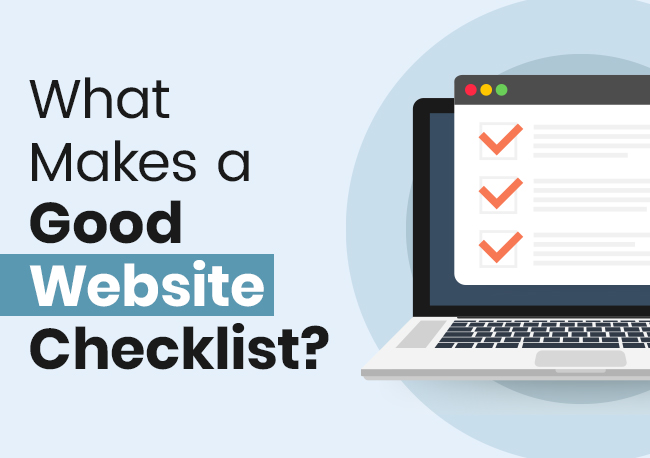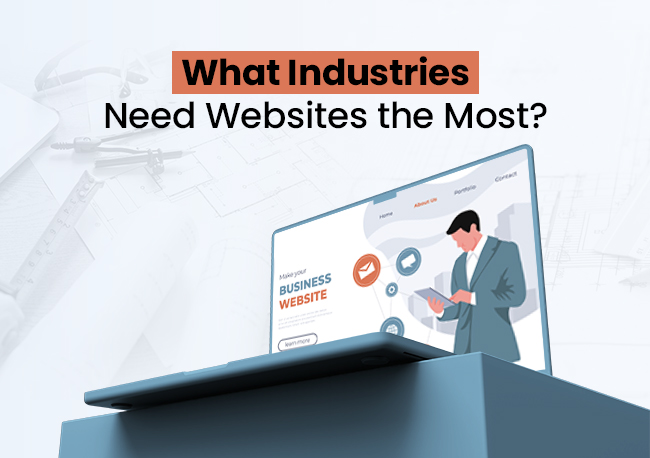| Getting your Trinity Audio player ready... |
What makes a good website checklist? This question is asked by many, answered by some, and understood by a few! Running a business online is as difficult and essential as running it offline. It’s like raising a second child where you know a lot of things but are still new to parenting.
Just like deciding what’s best for your child, from schooling to focusing on developmental skills, there are several aspects when building a website. Be it layout, qualitative & valuable content, user experience, and more.
You need to lay out a plan stating what is needed to accomplish the minor goals that lead you to creating a successful website.
To understand what makes a good website checklist, we must first understand why we need a good website.
Importance of a Good Website
What grabs your attention the most when surfing on a website online?
★ Is it the range of products or services they are offering?
Or
★ Is it the design that appeals to you the most?
Or
★ the fact that it loads the images and content faster than your typing speed?
Probably all!
Think of your website as the heart of your business. Just like nurturing your health, the more effort you put into it, the stronger it becomes. It’s the key to connecting with your customers on a deeper level and providing them with what they desire.
Your website is a magnet that pulls in your audience and gives them exactly what they’re looking for. It should be engaging, dynamic, and user-friendly so visitors can easily find what they’re looking for.
You have to create a professional website so that it appeals enough that they won’t be able to resist making a purchase.
Let’s dive deeper to know more!
What makes a Good Website Checklist?
Now that we’ve learned the importance of a good website, let’s take an example to understand better.
Imagine yourself entering a restaurant. You first notice the ambience, followed by how quick their service is, and lastly, the food (their main offering). These are the main criteria for rating a restaurant, right?
Similarly, what affects the most when someone visits your website depends on a few factors. Let’s take a look at what makes a good website checklist:
Also Read: What Is A Website Name?
1. User Friendly Design
Like the ambience of a restaurant, user-friendly design is important to a successful website for many reasons. The following are the essential components covering various design and usability aspects to ensure your website is user-friendly:

➔ Responsive Design: A web design strategy in which the website adapts to different screen sizes and devices, from large desktop monitors to smaller smartphones and tablets. It involves designing and coding websites or applications to ensure their content and layout dynamically accommodate different sizes.
A consistent user experience must be offered across all platforms. Adaptability is crucial in the contemporary digital environment, where consumers can access data on various devices with different screen sizes and resolutions.
In short, You have to focus on large monitors as well as give importance to the mobile-friendly website for a better overall user experience
Also Read: How To Create A Restaurant Website: 6 Steps You Must Know
➔ Easy-to-use Navigation: Easy navigation directly impacts the overall user experience. When visitors can easily find the information they’re looking for and navigate your site without difficulty, they are more likely to stay longer, engage with your content, and return in the future.
➔ Proper Content Hierarchy: A proper content hierarchy is essential to a good website as it ensures that information is organized clearly and logically, making it easier for visitors to navigate and find what they want.
The organization of the website content begins with a clear structure that lists the content’s core categories and subcategories, making it easier for visitors to understand the purpose and scope of the website.
Search engines can better understand and rank content when organized hierarchically, which is why a clear hierarchy is beneficial for search engine optimization (SEO).
A solid content hierarchy also improves the user experience by smoothly leading visitors across the website, which reduces frustration and increases the possibility of engagement and conversion. In essence, the foundation of a user-friendly and successful website is a carefully considered content hierarchy.
Also Read: What Are The Benefits Of A Website For Small Businesses
➔ Proper readability: A website’s readability measures how easy it is for users to read and understand the text on the web page. Proper readability depends on the context and presentation of the data, such as fonts, spacing, and color.
➔ Compatibility with Every Browser: This indicates that the design and functionality of the website or application are not restricted to a single web browser but rather function correctly and consistently on a wide range of commonly used web browsers.
Several popular web browsers include Google Chrome, Mozilla Firefox, Apple Safari, and Microsoft Edge.
Also Read: How To Start Your Travel Website?
2. Content Quality
When a restaurant offers a well-designed menu with a detailed dish description, the customers are more likely to order mouth-watering dishes. It is necessary for restaurants to have a thoughtfully crafted menu that offers what the customer is craving.
Just like that, a good website must have high-quality content as it not only provides valuable & informative content that engages individuals but also helps your site build credibility and rank well in search engines.

Regularly reviewing and improving your content according to the checklist above will help you maintain a high-quality website.
Here is why a good website must have high-quality content:
➔ Complete Relevancy: Complete relevance in content is essential for building trust, retaining an audience, and achieving the desired goals, whether that’s informing, engaging, influencing, or selling.
Users stay on your website longer, visit more pages, and perform desired actions like making purchases, etc., thanks to relevant content that keeps them interested and engaged.
It also helps search engines give websites with useful and high-quality content priority. Utilizing SEO-relevant keywords can improve a brand’s visibility in search result pages.
Your credibility is directly proportional to how accurate and thoroughly researched your information is. You can filter out and target your audience based on the right keywords and your audience’s preferences.
Maintaining a consistent tone, style, and voice for your brand is very important. It supports the development of a powerful and recognizable brand.
➔ Accuracy in Content: Accuracy in content quality is essential as it directly impacts the credibility and trustworthiness of the site.
Users rely on websites to deliver accurate and trustworthy information for research, education, or making well-informed decisions.
Inaccurate or deceptive content can spread misleading data, undermine user confidence, and harm a website’s reputation.
Therefore, sustaining user satisfaction, trustworthiness, and the overall usefulness of the website as a valuable resource depends on ensuring that the data is factual, up-to-date, and well-sourced.
➔ Full Clarity in Content: When you have clear, concise, and well-organized content on your website, it ensures that visitors can quickly understand the purpose of the website, find the information they seek, and navigate seamlessly.
In addition to establishing credibility and trust, clear content indicates competence and expertise. Users may get discouraged by unclear or confusing wordings, which can result in high bounce rates and decreased engagement.
Additionally, search engines reward websites with understandable and useful content, which raises their visibility and discoverability.
In order to ensure that users have a pleasant experience and can easily connect with the brand’s messages or products, achieving complete clarity in content is a vital component of a successful website checklist.
Also Read: Can I Blog To Improve The SEO Of Website?
➔ Originality: Original content sets your website apart from the competition and demonstrates your expertise and commitment to providing valuable information.
It guarantees that visitors will find relevant and interesting content, which will encourage them to return and engage with your website.
Moreover, original content contributes to higher search engine rankings, as search algorithms prioritize unique and high-quality content.
In the end, a website checklist must set a high priority on originality in order to not only draw in and keep a committed audience but also to improve exposure in search results and build a solid digital presence.
➔ User-Centric Content: When developing content for your website, you have to keep in mind what the consumers are looking for in terms of their needs, preferences, and interests; it is known as user-centric content.
User-centric content is crucial as it prioritizes the visitors’ needs and preferences and ensures that the information is not only accurate and well-structured but also interesting and relevant to the target audience.
To develop a unique browsing experience, user-centric content examines user behavior, feedback, and personality types. It aids in enhancing user satisfaction, raising engagement, and promoting conversions, eventually resulting in a more successful and effective website that achieves its objectives and lives up to users’ expectations.
➔ Fresh Content: Content is like food; the more you eat fresh, the better. And having fresh content is crucial for a good website for many reasons. Firstly, frequent changes show that the site is up-to-date and valuable, which helps attract and sustain visitors. Search engines also prefer new content, which leads to higher search rankings and more organic visitors.
Furthermore, recent data enhances the site’s authority and trustworthiness in its industry, promoting user trust. Incorporating current topics and keywords into new content also strengthens SEO efforts.
Additionally, it can entertain and educate the audience, enticing them to revisit and spread the word about the content, thus increasing the website’s visibility and significance in a fast-paced digital space.
➔ Clear CTA: A clear CTA (Call To Action) is necessary to have high-quality, engaging content that is both relevant and appealing to users. It’s crucial to guide them toward the next step.
It acts as a road map for visitors, pointing them in the direction of particular actions you want them to perform, such as completing a purchase, subscribing to your newsletter, or getting in touch with you.
In order to encourage user engagement, a well-designed CTA employs clear and appealing wording in addition to being aesthetically noticeable.
Also Read: Complete Guide To The Content Management System
3. Performance & Speed
The quality of its cuisine doesn’t solely determine the success of a restaurant; it also depends on how the staff treats customers. When customers experience prompt and attentive services, it satisfies their needs and fosters loyalty, ensuring a return for more culinary delights.

Similarly, a website’s user experience is one of the most important factors that pave the way towards success. A quick-loading website keeps visitors interested and enhances search engine rankings, as search algorithms prefer quick-loading pages.
Slow websites tend to frustrate users, increasing bounce rates and lowering conversion rates. Website performance optimization, including efficient code, optimized images, and responsive design, ensures a seamless browsing experience across devices and internet connections.
Additionally, user impression is affected by speed, and a quicker website is frequently perceived as a more dependable and trustworthy source. In today’s digital landscape, where attention spans are short, a well-performing and speedy website is crucial for attracting and retaining visitors, achieving business goals, and staying competitive.
The following are why performance and speed are necessary for a good website:
➔ Fast Page Loading: How would you react if the food service is exceptionally slow after placing an order at a restaurant? You’ll be frustrated, right? Similarly, when a user lands on your website, they anticipate a quick response in terms of site loading speed.
When pages load quickly, visitors are more likely to stay engaged, navigate the site, and take the desired action, leading to higher user satisfaction and conversion rates.
Slow-loading pages can discourage users, drive them away, and harm a website’s rankings, as search engines prioritize fast-loading sites.
For a good website, prioritize the quick turnaround time & fix your slow website by optimizing images, minimizing HTTP requests, leveraging browser caching, and utilizing content delivery networks (CDNs), as it not only enhances user experience but also contributes to better SEO and business outcomes.
Additionally, choosing the proper type of web hosting is crucial. For instance, buying a VPS server offers more control and flexibility for growing sites, while a dedicated server provides maximum performance and security for high-traffic websites. Selecting the right hosting ensures your site remains fast and reliable.
Also Read: Why Does My Website Load Slowly?
➔ Quality Server Performance: A seamless browsing experience depends on a server’s ability to deliver high-quality performance. A website’s server operates at peak efficiency when it guarantees quick loading times, uninterrupted access, and the capacity to handle huge traffic volumes effectively.
Since users are more inclined to stick around for longer on a quick and responsive site, this directly impacts consumer satisfaction and retention. A fast web hosting server can enhance a website’s search engine visibility, thereby enhancing your digital presence, as search engines like Google also consider website speed as a ranking factor.
Therefore, providing a great user experience and achieving online success depends heavily on a website’s stable and dependable server.

➔ Proper Optimized Images: Firstly, properly optimized images significantly impact how quickly the website loads, which is important for user experience and search engine ranking. Large, inefficient graphics may increase the page loading time, causing users to become impatient and leave the website.
Secondly, optimized images guarantee compatibility with a range of devices and screen sizes, improving the adaptability and accessibility of the website.
The website’s exposure in search engine results can be enhanced by optimizing photos with detailed descriptions, thus potentially increasing organic traffic. Making image optimization a top priority is crucial for developing an efficient and easy-to-use website.
➔ Mobile-Friendly Design: Considering the growing popularity of smartphones and tablets, a sizable amount of website traffic now originates from mobile devices. In order to offer a seamless and user-friendly experience to a wide audience, a website must be optimized for mobile.
A website with a mobile-friendly design has a flexible design, touch-friendly navigation, and quick loading times so that it can adapt to smaller displays and perform efficiently on smaller devices.
In addition to increasing consumer satisfaction, this improves website ranks on search engines like Google, which give preference to mobile-friendly websites.
Furthermore, as it directly affects user engagement, accessibility, and a website’s overall performance in today’s mobile-centric environment, mobile-friendly design is a vital aspect of an effective website development checklist.
4. Security and Privacy
The foundation of any website is the ability to earn and retain the trust of its users by committing to their privacy and security. The website and its users are protected from cyber-attacks by security measures such as strong encryption, firewalls, and regular software updates, ensuring data confidentiality, integrity, and availability.

Users’ personal information is protected, and their rights are preserved via privacy considerations such as open data processing procedures, consent systems, and compliance with relevant laws like the GDPR. So, it is required to have a privacy policy on the website.
A website that promotes security and privacy not only protects itself from breaches and legal consequences but also promotes a great user experience, which is essential for drawing in and keeping loyal customers in today’s competitive digital market.
Also Read: Best Practices To Secure Your Website
➔ SSL Certificate: An SSL (Secure Sockets Layer) certificate ensures that data being communicated between a user’s web browser and the website’s server is encrypted, protecting the confidentiality and integrity of sensitive information, including login passwords, personal information, and payment details.
The padlock icon in visitors’ browsers denotes a secure connection and helps develop trust while protecting user privacy. An SSL certificate can also improve a website’s visibility in search results because it is a crucial component of search engine ranking algorithms & the best part is that SSL helps in the SEO of your website.
Also Read: 9 Types Of SSL Certificates – Make The Right Choice
➔ Data Privacy of Users: User data privacy emphasizes protecting individuals’ rights and securing their data. This not only builds trust between the website and its users but also ensures compliance with legal and ethical standards.
A website that prioritizes data privacy will implement user consent processes, secure data encryption, and clear and accessible privacy policies. A website can improve its reputation and reduce the risk of data breaches by protecting user information from unauthorized access or misuse.
Data breaches can have serious consequences for the brand’s reputation as well as legal issues. Prioritizing data privacy in a website checklist is essential for long-term success and user pleasure in the current digital environment, when data breaches and privacy concerns are pervasive.
5. SEO and Searchability
SEO and searchability are essential since they directly impact a website’s visibility and reach. A website’s SEO strategy involves improving site components, including content, meta tags, and site architecture, to raise a website’s rating in search engine results. This increases organic traffic and ensures the correct audience can find the website.

Searchability refers to how user-friendly and simple the website is to navigate. To improve user experience, a website should be created with a transparent structure for data and a responsive design.
➔ Fully Optimized On-Page: Fully optimizing on-page SEO is important as it involves adjusting various kinds of web page elements to ensure they comply with search engine algorithms and user expectations. These components include meta tags, content quality, keyword utilization, page load speed, mobile friendliness, and internal linking.
Effective on-page SEO increases a website’s chances of ranking higher in search engine results pages (SERPs), drawing organic traffic and offering users an easy and educational experience.
A successful website checklist must include a well-optimized on-page approach because it not only improves a website’s search engine rankings but also greatly increases user engagement and satisfaction.
Also Read: How Many Keywords Can A Website Have For SEO?
➔ Optimized Technical SEO: Optimized technical SEO is important for a good website checklist, as it is the foundation of a strong online presence.
Technical SEO focuses on the behind-the-scenes aspects of a website that impact its search engine visibility and overall user experience. This involves improving the site’s design, fixing broken links and repetitive content, as well as speeding up the site, and making it mobile-friendly.
Optimized Technical SEO is the basis upon which other digital marketing efforts, such as content creation and link building, can thrive, making it a vital component of any effective website checklist.
Conclusion
Just like a successful restaurant relies on factors like ambiance, service speed, and food quality to impress customers, a good website checklist encompasses various critical elements essential for creating a successful online presence.
These elements include a user-friendly design, excellent performance and speed, engaging content, strong security and privacy measures, and effective SEO tactics.
High-quality content enhances credibility and relevance, while a user-friendly design ensures simple navigation and device flexibility. While security and privacy guarantee protected user information and trust, performance and speed, enhance user satisfaction and search engine rankings.
FAQs
Here are a few pointers to ensure your website is user-friendly:
➔ An intuitive navigation
➔ Simple and clear content
➔ Responsive design for multiple devices
➔ Fast page loading times
➔ Implement an attractive and structured design
➔ Utilize readable fonts
Lastly, to provide the best user experience, collect feedback from your audience and consistently improve your website depending on their needs and preferences.
An error-free website needs thorough testing and maintenance. Test your website across different browsers and devices to ensure compatibility. Check for broken links, missing images, and slow-loading pages.
Implement security measures to protect against vulnerabilities, and regularly update your content and plugins. Regularly review and optimize your website’s performance to provide a seamless user experience.




